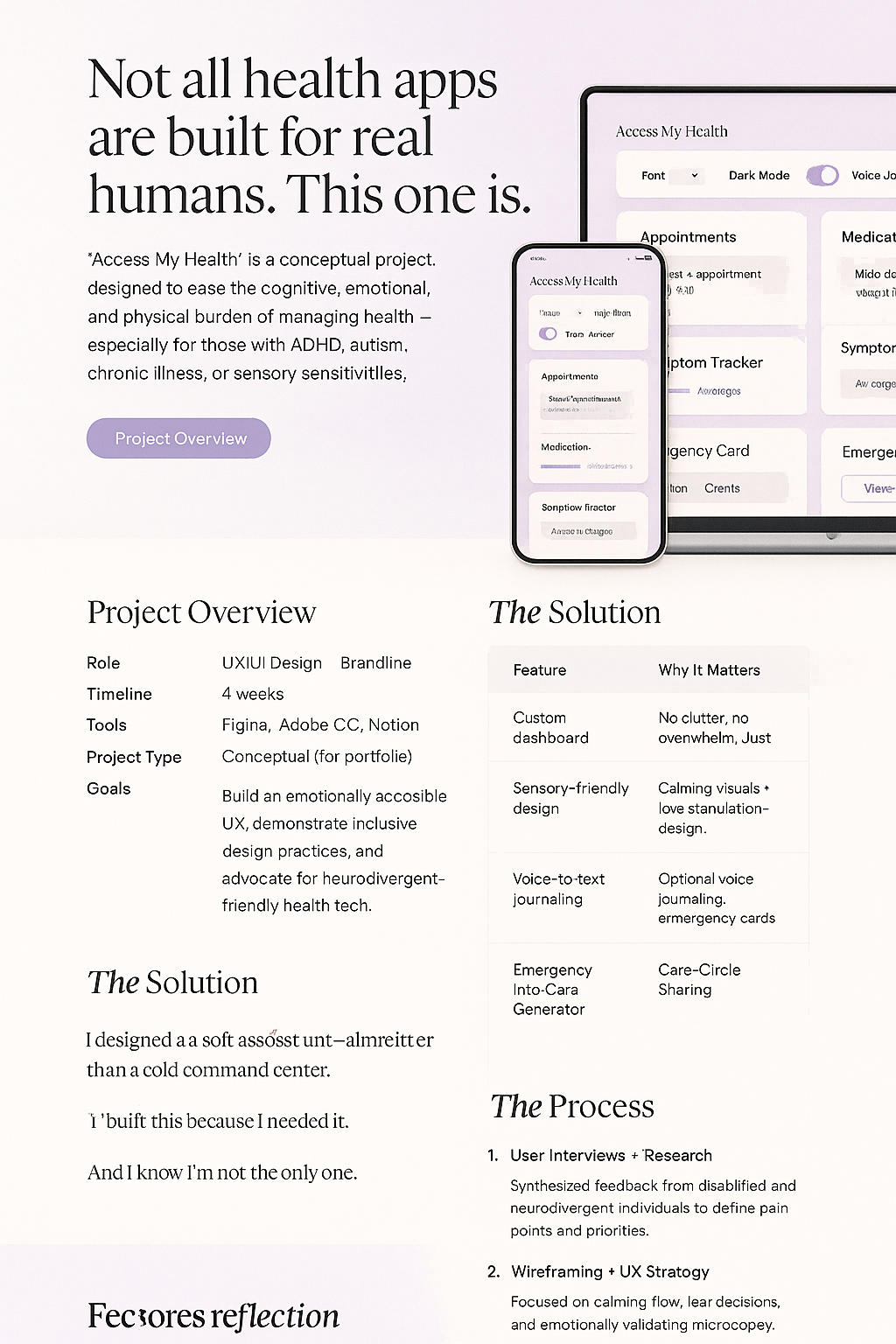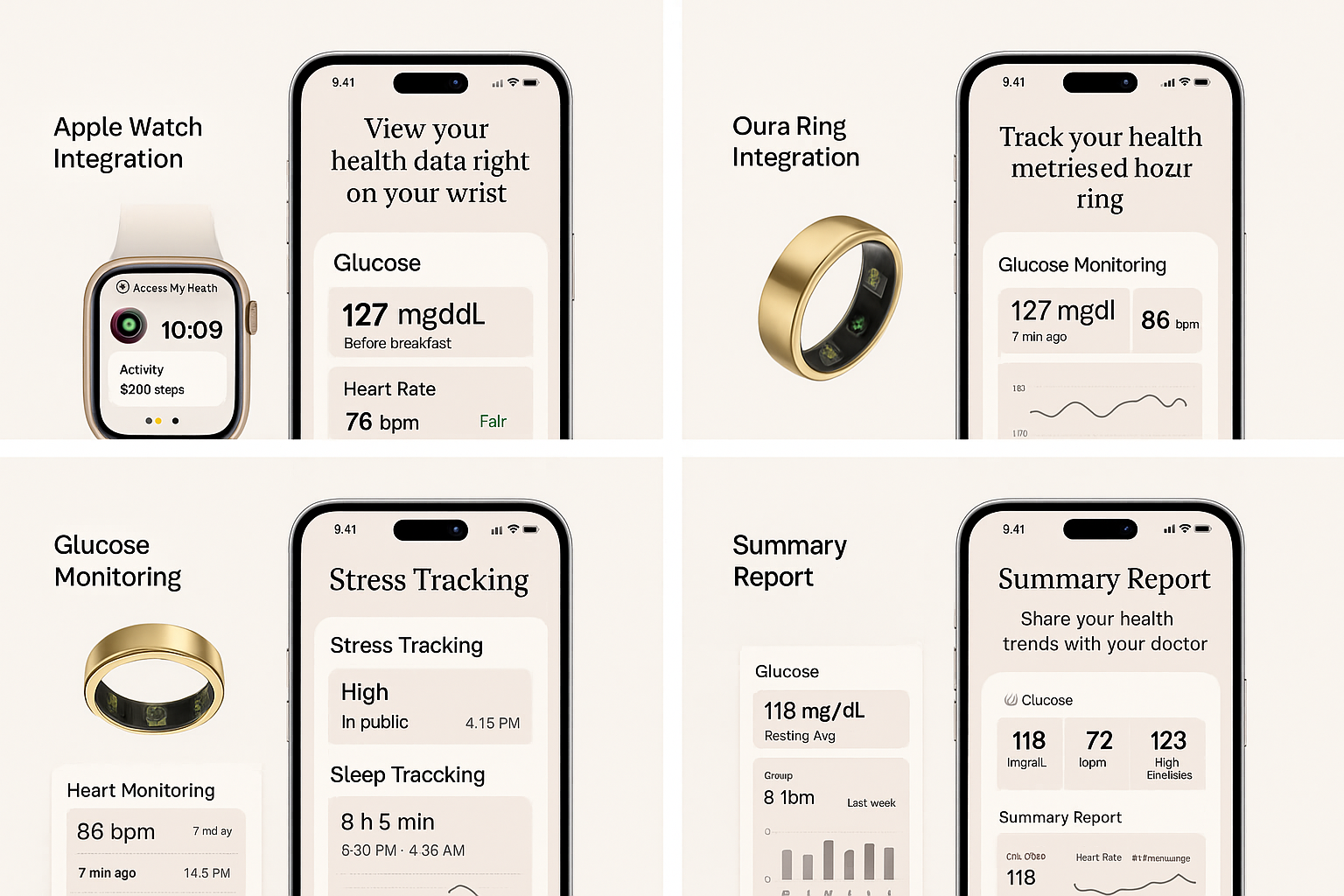Designing for Access: How I'm Using ChatGPT to Rethink Health UX for Neurodivergent and Disabled Users
When I started dreaming up a health app for neurodivergent and disabled folks, I wasn’t planning on actually building it.
I was just frustrated.
Frustrated with health apps that felt sterile and overwhelming. Frustrated with systems that assume everyone has perfect executive function and zero sensory sensitivity. Frustrated that every time I needed to manage my chronic illness or track symptoms, it felt like the tools were working against me.
So, I opened ChatGPT.
Not with a business plan. Just a problem, and an idea that’s lived rent-free in my head for years.
And that’s how Access My Health was born — a conceptual dashboard that reimagines health management through a neurodivergent-friendly lens. “Access My Health” is a conceptual project designed to ease the cognitive, emotional, and physical burden of managing health — especially for those with ADHD, autism, chronic illness, or sensory sensitivities.
Neurodivergent individuals frequently face a complex maze of overlapping and underrecognized health challenges—from ADHD and autism to POTS, EDS, chronic pain, anxiety, and sleep disorders. A sizable majority struggle with misdiagnosis or delayed diagnosis: one study revealed that 24.6% of autistic adults (rising to 31.7% among women) reported at least one prior psychiatric condition—such as anxiety, mood disorders, or ADHD—that was later perceived as a misdiagnosis (PMC). Another large-scale survey found that over 75% of participants received an autism diagnosis approximately eight years after initially seeking evaluations (Healthline). Meanwhile, up to 80% of autistic girls remain undiagnosed or misdiagnosed by age 18 (Australian Psychological Society)—a glaring gap that speaks to systemic diagnostic bias and oversight.
“Because Ehlers Danlose Syndrome and POTS are invisible, and so she looks relatively ‘normal,’ most people just assume that she is lazy and undriven.”
-urevolution.coM
This sentiment echoes far too many experiences. Studies show that over half of patients with invisible illnesses report their symptoms were dismissed by healthcare providers, sometimes labeled as stress or depression (eds.clinic). This dismissal not only delays appropriate care but also amplifies psychological distress: invalidation contributes to increased anxiety, depression, and social withdrawal (eds.clinic).
Taken together, these facts underline a stark truth: neurodivergent patients often endure years of misunderstanding, minimizing, or misdiagnosis. These experiences erode trust, delay necessary treatments, and burden people with chronic conditions to continually advocate just to be heard. That’s why tools like Access My Health, which consolidate objective, wearable-data insights into doctor-ready conversation starters, are so vital—they help translate invisible pain and cognitive distress into visible, credible health metrics.
Using ChatGPT as a Thought Partner
This wasn’t about asking AI to design for me. It was about designing with support — using ChatGPT like a whiteboard, a mentor, and a creative mirror all rolled into one.
Together, we:
Defined the user problems
Explored accessibility standards
Identified emotional pain points specific to neurodivergent users
Mapped out features like voice journaling, calming UI, and customizable care dashboards
Wrote a full UX case study, branding language, and even built a mockup storyboard
I wasn’t just getting “answers.” I was co-creating — rapidly iterating ideas, getting unstuck faster, and refining the vision in real time.
And honestly? It felt like having a very smart, non-judgy creative director on call.
Why This Matters
Accessibility is not a checklist. It’s a mindset. It’s asking:
How will this feel on a day when someone is in pain?
What about when they’re overstimulated, foggy, or grieving?
Will this make someone feel empowered — or ashamed?
I built this because I’ve lived it. I’ve worked through symptom flare-ups, navigated overlapping diagnoses, and managed life as a neurodivergent woman in a system not built for me.
This mock project let me channel that experience into something useful. Something kind. Something that proves accessible design can be just as beautiful, modern, and human-centered as any sleek SaaS product.
Tools I Used
ChatGPT: For brainstorming, structuring the case study, writing microcopy, and accessibility research
Figma: For wireframes and prototyping
DALL·E: To generate mockup visuals and bring the project to life on my site
Notion: For planning and documenting the UX strategy
What’s Next
This project is conceptual — for now.
But I plan to turn the design system into:
A Notion-based tracker for my shop
A downloadable template for neurodivergent creators
A resource in my upcoming Skool community for creative entrepreneurs
Because access shouldn’t be an afterthought. It should be baked in from the beginning — with empathy, imagination, and a little help from AI.
Imagining the app with Chat GPT
During my lunch break, I doodled some quick wireframes. After polishing them a bit in Figma, I handed it over to Chat in my custom GPT to flush out a rough idea of the future. Not too shabby, Chat!
I like the general vibe of the mockups regardless of how busy they are. It feels like a great “brain dump” moment- it’s finally out of my head and ready for a real design session.
Why This Matters: Making the Invisible Visible
Many neurodivergent people live with a web of overlapping conditions — ADHD, autism, anxiety, Ehlers-Danlos Syndrome (EDS), Postural Orthostatic Tachycardia Syndrome (POTS), and others. These comorbidities often go undiagnosed for years, dismissed by doctors as stress, burnout, or “just anxiety.”
But what if we had proof?
Thanks to wearable tech like the Oura Ring, WHOOP band, Apple Watch, and CGMs (continuous glucose monitors), we’re entering a new era: where invisible illnesses can finally leave a trail of visible data.
And data means advocacy.
With the Access My Health system, users can:
Track heart rate spikes that align with POTS symptoms
Log frequent joint instability to support EDS diagnosis
Monitor glucose crashes linked to fatigue or brain fog
Show sleep disruption during flare-ups
Document stress escalation in overwhelming environments
All of this gets compiled into simple, doctor-ready summary reports — turning hard-to-explain experiences into tangible conversation starters.
Because a spike in HRV or a sudden dip in glucose shouldn’t be a mystery. It should be a map.
A map that helps patients get the care they need — and deserve — without having to fight so hard to be believed.
If you're a designer or creator wondering whether using ChatGPT is “cheating,” I’d argue the opposite.
I think it’s a form of accessibility in itself.
It helps me work through brain fog. Organize ideas. Keep momentum going when ADHD might otherwise stall a project mid-sprint.
And just like any tool, its power depends on how you use it.
I'm using it to build better things — for more people.
And I think that’s pretty damn cool.
___________
This blog post was created with the assistance of AI (ChatGPT by OpenAI) to help organize research, generate draft language, and structure the content. All ideas and personal experiences shared reflect the author’s perspective, and all factual claims are supported by linked sources. Always consult a licensed medical professional for personal health concerns.



